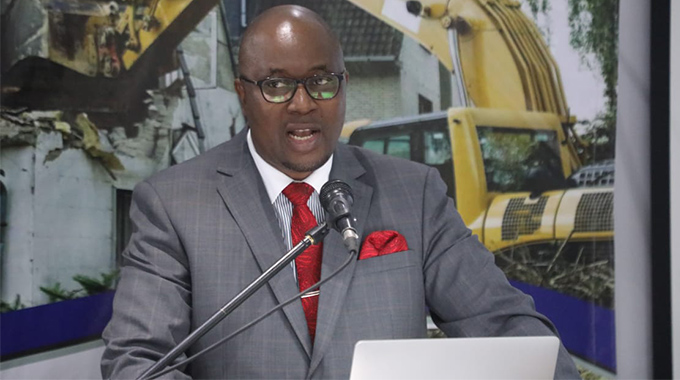JUST IN: Emergency road rehabilitation programme to create 20 000 jobs

Mashudu Netsianda, Senior Reporter
THE ongoing government-funded US$400 million Emergency Road Rehabilitation Programme 2 (ERRP2) recently launched by President Mnangagwa is set to create about 20 000 jobs for local communities, including opening up opportunities for women and the youth.
Cabinet recently declared the country’s road network a state of disaster as most of the roads have become untrafficable due to ageing and damage by heavy rains that were received during the past summer season.
Government has since mandated the Department of Roads to take over 500km of roads from urban councils.
According to the timelines set for this year, 840km of roads across the country will be rehabilitated and reconstructed while 8 340km will be re-gravelled with 17 093km of road network set to be regraded.
Speaking in Parliament, Transport and Infrastructural Development Deputy Minister Mike Madiro said the ERRP2 seeks to advance Government’s thrust on community involvement under the devolution drive including the empowerment of women and youths.
“From an economic perspective, the ERRP2 is expected to provide opportunities to private contractors and suppliers, ensuring their active participation and contribution to economic development while at the same time fostering their own growth. The programme shall, through labour-based road maintenance and rehabilitation activities as well as hiring of casual labour by contractors, create an estimated 20 000
jobs for local communities, including opportunities for women and youth,” he said.
“The ERRP2 therefore seeks to advance Government’s thrust on community involvement under the devolution drive as well as empowering women and youths towards the attainment of Sustainable Development Goals.”
Deputy Minister Madiro said ERRP 2 is premised on the concerted efforts of all road authorities in improving the condition of the country’s road infrastructure network in the next three years (2021 to 2023).
The programme is divided into three distinct phases.
“The first phase runs for a period of 12 months and targets projects which respond to emergency works in need of urgent attention such as washaway repairs, potholes patching, reseals, rehabilitation of isolated sections of the road, grading, re-gravelling and other routine maintenance activities,” said Deputy Minister Madiro.
“Phase two, which shall be implemented in the subsequent 12 months, will focus on full rehabilitation and reconstruction of failed sections of the road network. This will lead us to phase three which shall also be implemented in the last set of ensuing 12 months.”
The third phase will focus on reconstruction of bridges and other hydraulic structures which were previously damaged by cyclones which have affected the country in the past few years.
Funding for the programme will be resourced from the Treasury, ZINARA Road Fund and a portion of Devolution Funds meant for the implementation of road projects.
Deputy Minister Madiro said they have put robust measures in place to ensure that the resources are used efficiently for the benefit of needy communities.
He said transformative measures in infrastructural development are required to underpin the drive towards the attainment of Vision 2030.
“Deriving from the target prescribed by Item 498 of the National Development Strategy 1 (NDS1), to increase the number of kilometres of road network to meet Southern Africa Transport and CommunicationsCommission standards from five percent to 10 percent by 2025 and to increase the number of kilometres of road network in good condition
from 14 702km to 24 500km by 2025, we heeded the President’s call to prioritise and accelerate completion of ongoing road projects,” he said.
“The ERRP 2 is consistent with the collective aspiration and determination of the Government of the Second Republic to achieve an Empowered and Prosperous Upper Middle-Income Society by the year 2030.
Pursuant to this Vision 2030, Government will, for the next five years (2021 to 2025), be guided by interventions undertaken through the NDS1.”
Deputy Minister Madiro said the provision of an efficient transport system is a key enabler for the country’s economic growth and development.
“We are also aware as the Ministry that the productive sectors such as agriculture and mining, identified as key to the success of NDS1, will thrive on a good road network which facilitates the efficient transportation of people and goods between sources of raw materials and production centres as well as to diversified markets. It was therefore imperative that Government makes deliberate interventions in order to redress the bad state of our roads through the implementation of ERRP 2,” he said.
Under the programme, an estimated 50 000km of road infrastructure is targeted for rehabilitation and upgrading, giving an average of 5000km in each of the country’s 10 provinces.
As of 30 June 2021, road authorities had managed to do resealing of about 30,8 km. Rehabilitation and construction is now at 164,6km,
while 874km of road have been re-gravelled. A total of 4115, 8km of road have been graded so that it becomes trafficable.
“At least 333 drainage structures have been repaired and constructed. Furthermore, 42 wash-aways and gulley reclamation have been done.
Bush clearing has been achieved to the tune of 3 934, 95km and a total of 7 515km of road have been pothole patched,” said Deputy Madiro.
To date, at least 170 km stretch of road have been opened for traffic between Beitbridge and Harare-Chirundu. This is in line with the Sadc Protocol for the provision of a seamless regional integrated roadnetwork.”
@mashnets











Comments